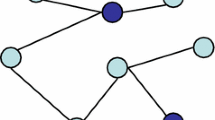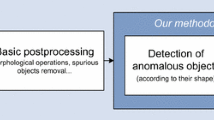Abstract
In this paper, a new self-organizing artificial neural network called growing hierarchical neural forest (GHNF) is proposed. The GHNF is a hierarchical model based on the growing neural forest, which is a tree-based model that learns a set of trees (forest) instead of a general graph so that the forest can grow in size. This way, the GHNF faces three important limitations regarding the self-organizing map: fixed size, fixed topology, and lack of hierarchical representation for input data. Hence, the GHNF is especially amenable to datasets containing clusters where each cluster has a hierarchical structure since each tree of the GHNF forest can adapt to one of the clusters. Experimental results show the goodness of our proposal in terms of self-organization and clustering capabilities. In particular, it has been applied to text mining of tweets as a typical exploratory data analysis application, where a hierarchical representation of concepts present in tweets has been obtained. Moreover, it has been applied to foreground detection in video sequences, outperforming several methods specialized in foreground detection.






Similar content being viewed by others
Notes
Reprinted from Computer Vision and Image Understanding, 133, Francisco Javier López-Rubio and Ezequiel López-Rubio, Features for stochastic approximation based foreground detection, 30–50, Copyright (2015), with permission from Elsevier.
References
Aizawa A (2003) An information-theoretic perspective of tf-idf measures. Inf Process Manage 39(1):45–65
Alahakoon D, Halgamuge SK, Srinivasan B (1998) A self-growing cluster development approach to data mining. In: 1998 IEEE international conference on systems, man, and cybernetics, 1998, vol 3, pp 2901–2906
Ashok P, Kadhar G, Elayaraja E, Vadivel V (2013) Fuzzy based clustering method on yeast dataset with different fuzzification methods. In: 2013 Fourth international conference on computing, communications and networking technologies (ICCCNT), pp 1–6
Astudillo CA, Oommen BJ (2014) Self-organizing maps whose topologies can be learned with adaptive binary search trees using conditional rotations. Pattern Recogn 47(1):96–113
Barbalho J, Duarte A, Neto D, Costa J, Netto M (2001) Hierarchical SOM applied to image compression. In: Marko K, Werbos P (eds) International joint conference on neural networks, 2001. Proceedings. IJCNN ’01, vol 1, pp 442–447
Bertolini G, Ramat S (2007) A hierarchical SOM to identify and recognize objects in sequences of stereo images. Springer, Berlin, pp 977–981
Bhandarkar SM, Koh J, Suk M (1997) Multiscale image segmentation using a hierarchical self-organizing map. Neurocomputing 14(3):241–272
Chen C, Yan F, Gao Y, Jin T, Zhou Z (2020) Improving reconstruction of sound speed profiles using a self-organizing map method with multi-source observations. Remote Sens Lett 11(6):572–580. https://doi.org/10.1080/2150704X.2020.1742940
de Amorim RC, Hennig C (2015) Recovering the number of clusters in data sets with noise features using feature rescaling factors. Inf Sci 324(C):126–145
Deerwester S, Dumais ST, Furnas GW, Landauer TK, Harshman R (1990) Indexing by latent semantic analysis. J Am Soc Inf Sci 41(6):391–407
Fatima N, Rueda L (2020) iSOM-GSN: an integrative approach for transforming multi-omic data into gene similarity networks via self-organizing maps. Bioinformatics 36(15):4248–4254. https://doi.org/10.1093/bioinformatics/btaa500
Fritzke B (1995) A growing neural gas network learns topologies. Adv Neural Inf Process Syst 7:625–632
Gemignani G, Rozza A (2016) A robust approach for the background subtraction based on multi-layered self-organizing maps. IEEE Trans Image Process 25(11):5239–5251
Goodfellow I, Bengio Y, Courville A (2016) Deep learning. MIT Press. http://www.deeplearningbook.org
Granados A, Koroutchev K, de Borja Rodriguez F (2015) Discovering data set nature through algorithmic clustering based on string compression. IEEE Trans Knowl Data Eng 27(3):699–711
Henriques R, Lobo V, Bação F (2012) Spatial clustering using hierarchical SOM, chap. 12. In: Johnsson M (ed) Applications of self-organizing maps. InTech, Rijeka
KaewTraKulPong P, Bowden R (2002) An improved adaptive background mixture model for real-time tracking with shadow detection. In: Remagnino P, Jones GA, Paragios N, Regazzoni C (eds) Video-Based Surveillance Systems. Springer, New York, pp 135–144
Kim J, Billard L (2011) A polythetic clustering process and cluster validity indexes for histogram-valued objects. Comput Stat Data Anal 55(7):2250–2262
Kohonen T (1982) Self-organized formation of topologically correct feature maps. Biol Cybern 43(1):59–69
Kohonen T (2013) Essentials of the self-organizing map. Neural Netw 37:52–65
Koikkalainen P, Oja E (1990) Self-organizing hierarchical feature maps. In: 1990 IJCNN international joint conference on neural networks, vol 2, pp 279–284
Krizhevsky A, Sutskever I, Hinton GE (2017) ImageNet classification with deep convolutional neural networks. Commun ACM 60(6):84–90
Kruskal JB (1956) On the shortest spanning subtree of a graph and the traveling salesman problem. Proc Am Math Soc 7:48–50
Lampinen J, Oja E (1992) Clustering properties of hierarchical self-organizing maps. J Math Imaging Vis 2(2):261–272
Liu Y, Takatsuka M (2009) Interactive hierarchical SOM for image retrieval visualization. Springer, Berlin, pp 845–854
López-Rubio FJ, López-Rubio E (2015) Features for stochastic approximation based foreground detection. Comput Vis Image Underst 133:30–50
Maddalena L, Petrosino A (2008) A self-organizing approach to background subtraction for visual surveillance applications. Trans Image Process 17(7):1168–1177
Maddalena L, Petrosino A (2010) A fuzzy spatial coherence-based approach to background/foreground separation for moving object detection. Neural Comput Appl 19(2):179–186
Martinetz T, Schulten K (1991) A “neural-gas” network learns topologies. Artif Neural Netw I:397–402
Miikkulainen R (1990) Script recognition with hierarchical feature maps. Connect Sci 2:83–101
Pakkanen J, Iivarinen J, Oja E (2004) The evolving tree—a novel self-organizing network for data analysis. Neural Process Lett 20(3):199–211
Palomo EJ, López-Rubio E (2016) Learning topologies with the growing neural forest. Int J Neural Syst 26(4):1650019
Palomo EJ, López-Rubio E (2017) The growing hierarchical neural gas self-organizing neural network. IEEE Trans Neural Netw Learn Syst 28(9):2000–2009
Rahmel J (1996) SplitNet: learning of tree structured Kohonen chains. IEEE Int Conf Neural Netw 2:1221–1226
Rauber A, Merkl D, Dittenbach M (2002) The growing hierarchical self-organizing map: exploratory analysis of high-dimensional data. IEEE Trans Neural Netw 13(6):1331–1341
Rousseeuw PJ (1987) Silhouettes: a graphical aid to the interpretation and validation of cluster analysis. J Comput Appl Math 20:53–65
Salton G, Buckley C (1988) Term-weighting approaches in automatic text retrieval. Inf Process Manage 24(5):513–523
Samsonova EV, Kok JN, Ijzerman AP (2006) TreeSOM: cluster analysis in the self-organizing map. Neural Netw 19(6–7):935–949
Sheikh Y, Shah M (2005) Bayesian modeling of dynamic scenes for object detection. IEEE Trans Pattern Anal Mach Intell 27(11):1778–1792
Stauffer C, Grimson W (1999) Adaptive background mixture models for real-time tracking. In: IEEE computer society conference on computer vision and pattern recognition, 1999, vol 2, pp 246–252
Wren C, Azarbayejani A, Darrell T, Pentland A (1997) Pfinder: real-time tracking of the human body. IEEE Trans Pattern Anal Mach Intell 19(7):780–785
Zhang X, Zhou X, Lin M, Sun J (2018) ShuffleNet: an extremely efficient convolutional neural network for mobile devices. In: Proceedings of the IEEE Computer society conference on computer vision and pattern recognition. arXiv:1707.01083
Zhu G, Wu X, Ge J, Liu F, Zhao W, Wu C (2020) Influence of mining activities on groundwater hydrochemistry and heavy metal migration using a self-organizing map (SOM). J Clean Prod 257:120664
Zivkovic Z (2004) Improved adaptive Gaussian mixture model for background subtraction. Proc Int Conf Pattern Recognit 2:28–31
Acknowledgements
This work is partially supported by the Ministry of Science, Innovation and Universities of Spain [Grant No. RTI2018-094645-B-I00], Project name Automated detection with low-cost hardware of unusual activities in video sequences. It is also partially supported by the Autonomous Government of Andalusia (Spain) under Project UMA18-FEDERJA-084, Project name Detection of anomalous behavior agents by deep learning in low-cost video surveillance intelligent systems. All of them include funds from the European Regional Development Fund (ERDF). The authors thankfully acknowledge the computer resources, technical expertise and assistance provided by the SCBI (Supercomputing and Bioinformatics) center of the University of Málaga. They also gratefully acknowledge the support of NVIDIA Corporation with the donation of the Titan X GPU used for this research. Finally, they are grateful to Mr Haritz Puerto-San-Román for providing the tweets dataset.
Author information
Authors and Affiliations
Corresponding author
Additional information
Publisher's Note
Springer Nature remains neutral with regard to jurisdictional claims in published maps and institutional affiliations.
Rights and permissions
About this article
Cite this article
Palomo, E.J., López-Rubio, E., Ortega-Zamorano, F. et al. Exploratory Data Analysis and Foreground Detection with the Growing Hierarchical Neural Forest. Neural Process Lett 52, 2537–2563 (2020). https://doi.org/10.1007/s11063-020-10360-2
Accepted:
Published:
Issue Date:
DOI: https://doi.org/10.1007/s11063-020-10360-2




